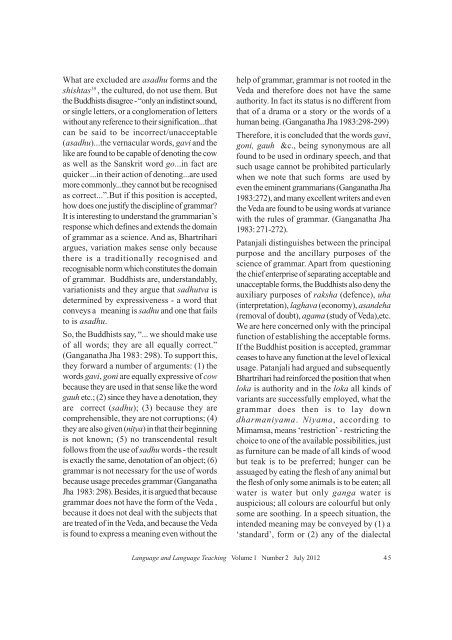Language and Language Teaching, Issue 2 - Azim Premji Foundation
Language and Language Teaching, Issue 2 - Azim Premji Foundation
Language and Language Teaching, Issue 2 - Azim Premji Foundation
Create successful ePaper yourself
Turn your PDF publications into a flip-book with our unique Google optimized e-Paper software.
What are excluded are asadhu forms <strong>and</strong> theshishtas 10 , the cultured, do not use them. Butthe Buddhists disagree - “only an indistinct sound,or single letters, or a conglomeration of letterswithout any reference to their signification...thatcan be said to be incorrect/unacceptable(asadhu)...the vernacular words, gavi <strong>and</strong> thelike are found to be capable of denoting the cowas well as the Sanskrit word go...in fact arequicker ...in their action of denoting...are usedmore commonly...they cannot but be recognisedas correct...”.But if this position is accepted,how does one justify the discipline of grammar?It is interesting to underst<strong>and</strong> the grammarian’sresponse which defines <strong>and</strong> extends the domainof grammar as a science. And as, Bhartrihariargues, variation makes sense only becausethere is a traditionally recognised <strong>and</strong>recognisable norm which constitutes the domainof grammar. Buddhists are, underst<strong>and</strong>ably,variationists <strong>and</strong> they argue that sadhutva isdetermined by expressiveness - a word thatconveys a meaning is sadhu <strong>and</strong> one that failsto is asadhu.So, the Buddhists say, “... we should make useof all words; they are all equally correct.”(Ganganatha Jha 1983: 298). To support this,they forward a number of arguments: (1) thewords gavi, goni are equally expressive of cowbecause they are used in that sense like the wordgauh etc.; (2) since they have a denotation, theyare correct (sadhu); (3) because they arecomprehensible, they are not corruptions; (4)they are also given (nitya) in that their beginningis not known; (5) no transcendental resultfollows from the use of sadhu words - the resultis exactly the same, denotation of an object; (6)grammar is not necessary for the use of wordsbecause usage precedes grammar (GanganathaJha 1983: 298). Besides, it is argued that becausegrammar does not have the form of the Veda ,because it does not deal with the subjects thatare treated of in the Veda, <strong>and</strong> because the Vedais found to express a meaning even without thehelp of grammar, grammar is not rooted in theVeda <strong>and</strong> therefore does not have the sameauthority. In fact its status is no different fromthat of a drama or a story or the words of ahuman being. (Ganganatha Jha 1983:298-299)Therefore, it is concluded that the words gavi,goni, gauh &c., being synonymous are allfound to be used in ordinary speech, <strong>and</strong> thatsuch usage cannot be prohibited particularlywhen we note that such forms are used byeven the eminent grammarians (Ganganatha Jha1983:272), <strong>and</strong> many excellent writers <strong>and</strong> eventhe Veda are found to be using words at variancewith the rules of grammar. (Ganganatha Jha1983: 271-272).Patanjali distinguishes between the principalpurpose <strong>and</strong> the ancillary purposes of thescience of grammar. Apart from questioningthe chief enterprise of separating acceptable <strong>and</strong>unacceptable forms, the Buddhists also deny theauxiliary purposes of raksha (defence), uha(interpretation), laghava (economy), as<strong>and</strong>eha(removal of doubt), agama (study of Veda),etc.We are here concerned only with the principalfunction of establishing the acceptable forms.If the Buddhist position is accepted, grammarceases to have any function at the level of lexicalusage. Patanjali had argued <strong>and</strong> subsequentlyBhartrihari had reinforced the position that whenloka is authority <strong>and</strong> in the loka all kinds ofvariants are successfully employed, what thegrammar does then is to lay downdharmaniyama. Niyama, according toMimamsa, means ‘restriction’ - restricting thechoice to one of the available possibilities, justas furniture can be made of all kinds of woodbut teak is to be preferred; hunger can beassuaged by eating the flesh of any animal butthe flesh of only some animals is to be eaten; allwater is water but only ganga water isauspicious; all colours are colourful but onlysome are soothing. In a speech situation, theintended meaning may be conveyed by (1) a‘st<strong>and</strong>ard’, form or (2) any of the dialectal<strong>Language</strong> <strong>and</strong> <strong>Language</strong> <strong>Teaching</strong> Volume 1 Number 2 July 2012 45
















